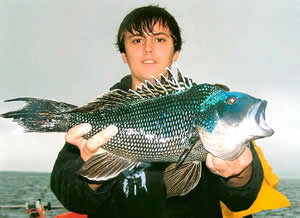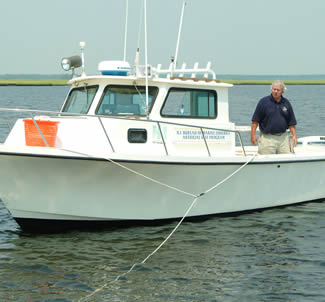Reef Tactics for Black Sea Bass
By Hugh Carberry, Reef Coordinator
Spring black sea bass fishing on New Jersey's artificial reefs can be fast and furious. Having a successful day depends on many factors, such as getting to your chosen reef site early, using an appropriate angling method, and finding a good anchoring location. The strategies discussed in this article will increase your hook up percentage leaving you with aching arms and great memories.
Beginners, novice and seasoned veterans all know that squid or clam fished on a top and bottom rig will always catch black sea bass. However, one method that can be equally effective is the use of a jig. Jig fishing for black seabass means no freshening up your bait, and when it works it can be absolutely deadly! The rig consists of three feet of 50-pound fluorocarbon leader with a 3-ounce egg sinker sliding freely above a 30-pound snap swivel. A ½ ounce jig head is tied to the end of your three-foot leader. This rig is effective when fishing less than 70-feet of water. If you fish deeper you will want to tie your weight to the leader instead of having it free sliding above the swivel, as it will tangle every time you drop it down. As with any jigging, certain colors work better than others do. If one color does not work try another. For instance, you may be catching black seabass like crazy on chartreuse and then switch to motor oil and have your catch ratio drop in half. My experience has shown that the larger black seabass will usually hit the jig. Smaller black seabass avoid it. Anchoring location and technique separates the haves and have nots in reef fishing. A seasoned wreck angler who can place his boat directly over the most productive part of the wreck (usually the area with the highest relief) will out fish those who are on the periphery. Many novice wreck anglers have experienced the sight of people pulling in fish after fish at twice the rate that they are! What is different? Their boat is directly over the best part of the wreck and remains stationary. This angler has done his homework and knows through years of experience where the fish are on the wreck. It takes time to find the most productive part of a wreck, and by no means does it remain the same. Sea conditions, wind direction and currents are all part of the equation. The best method to quickly assess where fish are concentrated is by making several passes over the wreck while closely watching your depth finder. As you go along, mark these concentrations with man over boards (MOBs) or waypoints on your GPS. However, keep in mind that conditions are dynamic on the seafloor especially at the wreck interface. As conditions change with the tide, one area of the wreck that is producing fish like gangbusters may suddenly go quiet. One feature to note as you are scanning the reef for fish is the highest point. This location should be saved on your GPS permanently and named appropriately. At this location, bottom currents are directed upwards at the highest rate creating turbulence. This turbulence creates eddies and upwelling that black sea bass key in on for feeding. Remaining in place over this area is critical for successful fishing. There are several anchoring systems that may be utilized to position your vessel precisely over reef material. One method that works well is a modified bridling technique that can be accomplished using a single anchor.
When you have made the determination that you have traveled far enough up wind and up tide of the marker floats, deploy your anchor making sure you have an adequate length of anchor line. Pay out anchor line until your vessel approaches the floats marking the targeted structure and then tie off. Hopefully you will have executed this procedure correctly and positioned your vessel directly over the target. Should you discover that you are not precisely positioned due to slight variations in the wind or current, you have one more option to consider before retrieving and resetting. This option is to rig a modified bridle using 30 feet of ½-inch nylon rope with a stainless steel snap hook on the end. Attach the snap hook over the primary anchor line after pulling in several feet of slack and tie off the other end on an amidships cleat, either on the port side or starboard side. This will enable you to have the ability to glide several feet towards the reef structure by simply adjusting the steering wheel to port or starboard. Adjusting the ½-inch line on the amidships cleat and steering wheel position will allow you to slightly alter the vessels location and enable you to drift over the target. If the desired position is not achieved, try placing the ½-inch nylon rope on the opposite side (port or starboard) amidships cleat. This method works quite well most of the time, but it can become difficult if the wind and tide are opposing each other and there is not much drift. Fishing for black sea bass is a spring ritual that everyone can enjoy. The techniques described here will give you the tools and the opportunities to catch more fish. However, taking coolers of black sea bass home only to have them spoil by freezer burn is not a good use of this valuable resource. Exercise restraint when fishing and only save what you can eat in one meal. By doing this, there will be plenty of fish available for more fishing excursions, as well as for other anglers |
||||||||
|
||
|
|
||
|
||
| |
||


